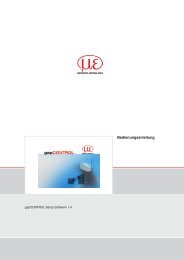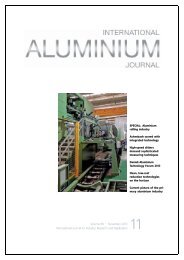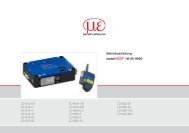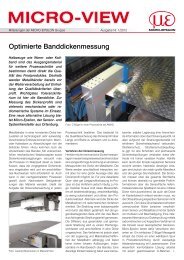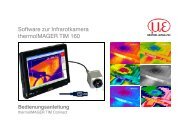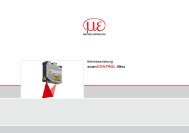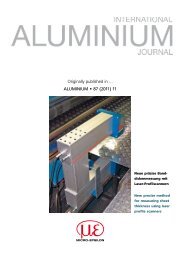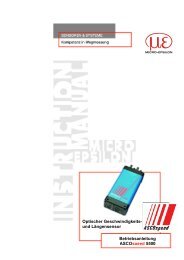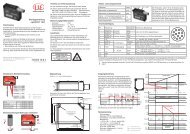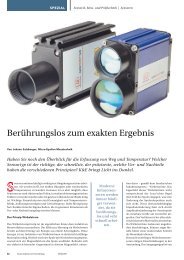Berührungslose Geschwindigkeitsmessung sorgt für stabile ...
Berührungslose Geschwindigkeitsmessung sorgt für stabile ...
Berührungslose Geschwindigkeitsmessung sorgt für stabile ...
Sie wollen auch ein ePaper? Erhöhen Sie die Reichweite Ihrer Titel.
YUMPU macht aus Druck-PDFs automatisch weboptimierte ePaper, die Google liebt.
EAFA<br />
Special: Aluminium<br />
rolling industry<br />
Interview with EAFA<br />
president François Coëffic<br />
Heat treatment<br />
with Otto Junker<br />
10<br />
Volume 86 · October 2010<br />
International Journal for Industry, Research and Application<br />
German aluminium industry<br />
up to speed again
A L U M I N I U M w A L z I N D U S T R I e<br />
<strong>Berührungslose</strong> <strong>Geschwindigkeitsmessung</strong><br />
<strong>sorgt</strong> <strong>für</strong> <strong>stabile</strong> Bandqualität<br />
K. Christofori, Th. Rümmler; Micro-epsilon<br />
Länge und Geschwindigkeit<br />
gehören zu den meistgefragten<br />
Messgrößen in den technologischen<br />
Prozessen der Aluminiumindustrie.<br />
Diese werden in der<br />
Regel über mitlaufende Rollen<br />
oder Laufräder erfasst, die an<br />
gewünschter Stelle mit einem<br />
definierten Auflagedruck auf das<br />
Material gepresst werden. Ist der<br />
direkte Kontakt des mechanischen<br />
Gebers zum Messobjekt ausreichend,<br />
so folgt dieser dem zu messenden<br />
Material und liefert über<br />
einen Impulsgeber die gewünschten<br />
Längenimpulse. Die abgespulte<br />
Länge korrespondiert mit der<br />
Pulszahl und dem Durchmesser.<br />
Aufgesetzte Laufräder hingegen<br />
besitzen nur sehr kleine Kontaktflächen,<br />
was bei Dynamik in der<br />
Geschwindigkeit sowie in der Materialführung<br />
zu Schlupf führt.<br />
Beim Einsatz von Umlenkrollen<br />
ist man bestrebt, über den Umschlingungswinkel<br />
die Kontaktfläche<br />
zu erhöhen. Aber auch hier<br />
kann es in kurzzeitigen Beschleunigungsphasen,<br />
unter anderem durch<br />
Zugänderungen, zu merklichem<br />
Schlupf kommen, da die Rolle infolge<br />
ihres Gewichts und Trägheit<br />
der Bewegung nicht mehr folgen<br />
kann und rutscht. Empfindliche<br />
Bandmaterialien bekommen dann<br />
Kratzer. Die Oberfläche der Rolle<br />
verschleißt und ruft im schlimmsten<br />
Fall sogar Rattermarken auf<br />
dem Material hervor. Es gibt aber<br />
auch Prozesse, wo eine taktile Messung<br />
aus technologischer Sicht gar<br />
nicht möglich ist. Das betrifft sehr<br />
weiche Materialien bzw. heiße oder<br />
geölte Oberflächen. Hier ist man<br />
auf eine berührungsfreie Messung<br />
zwingend angewiesen.<br />
Berührungsfrei arbeitende Geschwindigkeitsmessgeräte<br />
<strong>für</strong> bewegte Oberflächen<br />
nutzen die Gittermodulation.<br />
Ein optisches Gitter, das als Referenzmaßstab<br />
fungiert, wandelt die Bewe-<br />
Non-contact speed measurement<br />
helps to ensure stable strip quality<br />
K. Christofori, Th. Rümmler; Micro-Epsilon<br />
Abb. 1: ASCOspeed 5500 zur berührungsfreien <strong>Geschwindigkeitsmessung</strong><br />
Fotos: Micro-Epsilon<br />
Fig. 1: ASCOspeed 5500 for non-contact speed measurement<br />
Length and speed are among<br />
the most frequently required<br />
measurement parameters in the<br />
technological processes of the aluminium<br />
industry. As a rule they<br />
are determined by rotating rollers<br />
or contact wheels pressed against<br />
the material at suitable points<br />
under a defined contact pressure.<br />
If the mechanical indicator makes<br />
sufficient firm and direct contact<br />
with the object being measured,<br />
it follows the material to be measured,<br />
via a pulse emitter, delivers<br />
the desired length pulses. The<br />
unwound length corresponds to<br />
the number of pulses and the diameter.<br />
However, laidon contact<br />
wheels have only very small con<br />
tact areas, and in<br />
the event of instability<br />
in the speed<br />
or material guiding<br />
dynamics this can<br />
result in slipping.<br />
When deflection<br />
rolls are used<br />
it is attempted, by<br />
virtue of the wraparound<br />
angle, to increase<br />
the contact<br />
area. But here too,<br />
in brief acceleration<br />
phases caused,<br />
among others, by<br />
tension variations,<br />
appreciable slip<br />
can take place<br />
since, as a result<br />
of its weight and<br />
inertia; the roll<br />
can no longer follow<br />
the movement<br />
but instead slides.<br />
Scratches then appear<br />
on sensitive<br />
strip materials. The roll surface<br />
wears, and in the worst case can<br />
even produce chatter marks on<br />
the material. There are also processes<br />
in which, for technological<br />
reasons, tactile measurement is<br />
not even possible. This is the case<br />
with very soft materials, or hot<br />
or oiled surfaces. A noncontact<br />
measurement method is then essential.<br />
Speed measurement instruments<br />
working without contact for moving<br />
surfaces make use of grid modulation.<br />
An optical grid, which functions as a<br />
reference scale, converts the movement<br />
into an electrical frequency.<br />
For this the grid has to be made very<br />
46 ALUMINIUM · 10/2010
A S LPU M e ICN I I UA MLw A L z I N D U S T R I e A L U M I N I U M R o L L I N G I N D U S T R Y<br />
precisely. The embodiment of the<br />
measurement is comparable to the<br />
graduation of a measurement strip or<br />
a micrometer. Nowadays, grids can<br />
be produced highly accurately and<br />
reproducibly as active silicon structures.<br />
With the masking technology<br />
used in semiconductor chip production<br />
the structural dimensions of the<br />
chips are absolutely identical and<br />
therefore provide ideal prerequisites<br />
for a mass-produced sensor.<br />
This is also the decisive advantage<br />
compared with the laser-Doppler<br />
technique, whose grid is produced<br />
by interference between laser beams<br />
from the same source and thus depends<br />
on the intersection angle and<br />
the laser wavelength. In that context<br />
the wavelength has to remain very<br />
stable, even taking into account thermal<br />
loading as for example in a rolling<br />
mill. Besides, a laser grid is produced<br />
on the surface of the material measured<br />
and is therefore affected by any<br />
interfering factors (dust, oil, emulsion,<br />
vapours, etc.). For these reasons<br />
Micro-Epsilon prefers active silicon<br />
grids which work with LED light.<br />
The company, located in Ortenburg,<br />
is known for its broad range of<br />
physical methods for path measurement.<br />
Optical triangulation sensors<br />
and high-precision eddy current or<br />
capacitative sensors are used to detect<br />
distances or thicknesses even in<br />
rugged surroundings.<br />
The ASCO speed 5500 is a compact<br />
instrument for the non-contact<br />
measurement of material speeds up to<br />
a maximum of 3000 m/min (Fig. 1). A<br />
temperature-data logger monitors the<br />
thermal load and records inadmissible<br />
excesses. The most modern signal<br />
processing structures ensure that any<br />
change in the speed of the material<br />
is determined with precision. This is<br />
done by super-rapid hardware, which<br />
records, checks and compresses the<br />
instantaneous speed values in the microsecond<br />
range. Only in this way can<br />
the greatest precision be achieved in<br />
the acceleration processes. Depending<br />
on the option chosen, the instrument<br />
has up to three scaled pulse<br />
channels with the usual quadrature<br />
outputs and can therefore be used<br />
in a multivalent manner as an alter-<br />
➝<br />
ALUMINIUM · 10/2010<br />
gung in eine elektrische Frequenz.<br />
Dazu muss das Gitter sehr präzise<br />
ausgeführt sein. Die Maßverkörperung<br />
ist vergleichbar mit der Strichteilung<br />
eines Maßbandes oder einer<br />
Mikrometerschraube. Gitter können<br />
heute als aktive Strukturen aus Silizium<br />
hochgenau und reproduzierbar<br />
hergestellt werden. Mit der Maskentechnologie<br />
in der Halbleiterchipherstellung<br />
sind die Strukturabmessungen<br />
der Chips absolut identisch<br />
und bieten somit ideale Voraussetzungen<br />
<strong>für</strong> einen Seriensensor.<br />
Das ist auch der entscheidende<br />
Vorteil gegenüber der Laser-Doppler-<br />
Technik, deren Gitter durch Interferenz<br />
zweier Laserstrahlen der gleichen<br />
Quelle erzeugt wird und somit<br />
vom Schnittwinkel und der Laserwellenlänge<br />
abhängig ist. Dabei muss die<br />
Wellenlänge auch unter Berücksichtigung<br />
der thermischen Belastung, zum<br />
Beispiel in einem Walzwerk, sehr stabil<br />
bleiben. Ferner entsteht das Gitter<br />
beim Laser auf der Oberfläche des<br />
Messgutes, ist also allen Störungen<br />
(Staub, Öl, Emulsion, Dampf usw.)<br />
ausgesetzt. Aus diesem Grunde setzt<br />
Micro-Epsilon auf aktive Silizium-<br />
Gitter, die mit LED-Licht arbeiten.<br />
Das Unternehmen aus Ortenburg<br />
ist bekannt <strong>für</strong> sein breites Spektrum<br />
an physikalischen Verfahren zur<br />
Wegmessung. Optische Triangulationssensoren,<br />
präzise Wirbelstromoder<br />
kapazitive Sensoren detektieren<br />
in rauher Umgebung Abstände oder<br />
Dicken.<br />
Das ASCOspeed 5500 ist ein Kompaktgerät<br />
zur berührungsfreien <strong>Geschwindigkeitsmessung</strong><br />
bis zu Materialgeschwindigkeiten<br />
von max. 3.000<br />
m/min (Abb. 1). Ein Temperatur-Datenlogger<br />
überwacht die thermische<br />
Belastung und registriert unzulässige<br />
Überschreitungen. Modernste Signalverarbeitungsstrukturen<br />
garantieren,<br />
dass jede Änderung der Materialgeschwindigkeit<br />
präzise erfasst wird.<br />
Da<strong>für</strong> <strong>sorgt</strong> eine superschnelle Hardware,<br />
die die momentanen Geschwindigkeitswerte<br />
im Mikrosekundenbereich<br />
registriert, prüft und verdichtet.<br />
Nur damit lässt sich höchste Präzision<br />
bei Beschleunigungsvorgängen realisieren.<br />
Das Gerät besitzt je nach Option<br />
bis zu drei unterschiedlich skalierbare<br />
Impulskanäle mit den üblichen<br />
Quadraturausgängen und ist damit<br />
als Drehgeberalternative multivalent<br />
einsetzbar.<br />
Für den Einsatz des Sensors werden<br />
keinerlei Anforderungen an die<br />
Struktur der Oberfläche gestellt. Farbe<br />
und Farbwechsel, unterschiedliche<br />
Beschichtungen werden ebenso wie<br />
sich verändernde Reflexionseigenschaften<br />
des Materials toleriert. Eine<br />
langzeit<strong>stabile</strong> LED-Beleuchtung ermöglicht<br />
einen weitgehend wartungsfreien<br />
Betrieb.<br />
Heute kommt die berührungslose<br />
Messtechnik mittlerweile nahezu<br />
durchgehend in den Bandprozessen<br />
der Metallindustrie zum Einsatz. Dies<br />
beginnt schon in den Vorwalzprozessen<br />
und endet in der finalen Oberflächeninspektion<br />
und Adjustage.<br />
walzprozesse<br />
In der Aluminiumindustrie beginnt<br />
der Prozesseinsatz der ASCOspeed-<br />
Sensoren schon in den Warmwalzgerüsten,<br />
wo die <strong>stabile</strong> Messwerterfassung<br />
blanker Materialien unter<br />
extremsten Bedingungen eine entscheidende<br />
Rolle spielt. Obwohl das<br />
Edelstahlgehäuse bereits einen guten<br />
mechanischen Schutz darstellt, sind<br />
<strong>für</strong> Anwendungen im Warmwalzwerk<br />
weitere Vorkehrungen <strong>für</strong> einen<br />
sicheren Betrieb zu treffen. Bei<br />
einer Integration in den Rollgang<br />
misst das ASCOspeed von unten und<br />
benötigt Spülluft zur Freiblasung des<br />
Messpfades. Die Luft erzeugt gleichzeitig<br />
einen Überdruck im Gerät und<br />
verhindert damit ein Eindringen von<br />
Emulsion und ein Verschmutzen der<br />
Optik. Die Synchronisation der Rollgangsgeschwindigkeit<br />
mit der des<br />
Walzgutes ist hier die vorrangige Anwendungsaufgabe.<br />
Mit dem Kaltwalzen folgt ein weiteres<br />
Veredeln des Bandes. Warmband<br />
oder Kaltband wird dabei durch<br />
weitere Walzschritte bis hin zur Fertigdicke<br />
reduziert. Ein maßgebliches<br />
Qualitätsmerkmal von Kaltwalzprodukten<br />
stellt die Dickentoleranz dar,<br />
deren Sicherstellung sehr eng mit einer<br />
korrekten Erfassung der Bandgeschwindigkeit<br />
verknüpft ist. Moderne<br />
Regelungskonzepte können aus der<br />
Geschwindigkeitsänderung durch<br />
Messen vor und nach dem Walz-<br />
native for a rotation indicator. ➝<br />
47
A L U M I N I U M w A L z I N D U S T R I e<br />
gerüst die Längung des Materiales in<br />
die Dickenänderung umrechnen und<br />
so eine Dickenkonstanzregelung aufbauen.<br />
Die resultierende Messung der<br />
Ausgangsdicke dient dann als Qualitätskontrolle<br />
zum Soll-Ist-Vergleich.<br />
Die Längung ergibt sich aus der Geschwindigkeitsdifferenz,<br />
weil beim<br />
Kaltwalzen die Verformungsrichtung<br />
in Bewegungsrichtung erfolgt und die<br />
Breitung zu vernachlässigen ist.<br />
Der Einsatz einer berührungsfreien<br />
Geschwindigkeitserfassung in<br />
Walzprozessen hat entscheidende<br />
Vorteile <strong>für</strong> die Regelungsdynamik<br />
und das Regelverhalten. Je exakter<br />
durch Materialverfolgung ermittelt<br />
wird, wann die erfasste Dicke im<br />
Walzspalt ist, desto schneller kann<br />
auch auf die Anstellung der Walzen<br />
eingewirkt werden. Das ist besonders<br />
in den Beschleunigungsphasen von<br />
Vorteil, wenn nach<br />
Aufspannen des<br />
Coils das Gerüst auf<br />
Arbeitsgeschwindigkeit<br />
hochgefahren<br />
wird. Hier ist eine<br />
synchrone Messung<br />
der Geschwindigkeit<br />
wichtig, da ein<br />
zeitlichen Versatz<br />
zwischen den Messungen<br />
eine fehlerhafte<br />
Differenz ergeben<br />
würde.<br />
Zum Einsatz<br />
kommt hier das Synchronmodell<br />
aus der<br />
ASCOspeed-Serie<br />
(Abb. 2). Die Messköpfe<br />
werden vor<br />
und nach dem Gerüst<br />
montiert. Über einen<br />
Synchronimpuls aus<br />
der Steuerung wird<br />
der Messablauf auf<br />
den Zyklus der Regelung abgestimmt.<br />
Dazu besitzt das ASCOspeed einen<br />
eigens da<strong>für</strong> ausgelegten Synchronsignaleingang.<br />
Die Synchronisation<br />
erfolgt vollkommen auf Hardwarebasis<br />
und taktet die Chipsätze, die die<br />
Messwerterfassung und Auswertung<br />
im ASCOspeed vornehmen. Dadurch<br />
gibt es quasi keine unkalkulierbaren<br />
Verzögerungszeiten, wie sie nachteilig<br />
bei Softwarekomponenten immer<br />
wieder auftreten.<br />
Reckprozesse<br />
Nach abgeschlossener Bandveredelung<br />
dienen Reckanlagen der Überstreckung<br />
des vorgefertigten Bandes<br />
in den plastischen Bereich, um unplane<br />
Abschnitte und damit wellige<br />
Bereiche förmlich „auszubügeln“. Das<br />
ist insbesondere bei der Herstellung<br />
von Druckplatten aus Aluminium von<br />
Bedeutung. Um in den Druckereien<br />
als Matrizen auch die gewünschte<br />
Druckqualität zu gewährleisten, werden<br />
höchste Ansprüche an die Planheit<br />
gestellt. Prozesstechnisch gilt es<br />
beim Recken den Reckgrad, also das<br />
Verhältnis der Längung, sehr genau<br />
einzustellen. Das geschieht durch<br />
Messung der Geschwindigkeit vor und<br />
nach den Recktrommeln. Die relative<br />
Geschwindigkeitsdifferenz entspricht<br />
dann dem Reckgrad. Besonders die<br />
Abb. 2: Synchronmodell aus der ASCOspeed-Serie<br />
Fig. 2: Synchronous model from the ASCOspeed series<br />
unterschiedlichen Beölungsgrade des<br />
Bandes gestalten eine mechanische<br />
Messung an den Rollensätzen als unzuverlässig.<br />
In diesem Prozessschritt bietet<br />
eine berührungslose Messung Vorteile<br />
aufgrund der trägheitslosen und<br />
schlupffreien Messwerterfassung<br />
(Abb. 3). Zugänderungen und eine dynamische<br />
Prozessgeschwindigkeit erfordern,<br />
ähnlich wie in Walzgerüsten,<br />
eine taktsynchrone Messwertaufnah-<br />
For the sensor to be used, there are<br />
no special requirements for the structure<br />
of the surface. Colours and colour<br />
changes, different coatings and varying<br />
reflection properties of the material<br />
are equally well tolerated. Long-life<br />
and stable LED illumination enables<br />
largely maintenance-free operation.<br />
Nowadays the use of no-contact<br />
measurement methods has become<br />
almost universal in the strip processes<br />
of the metal industry. This begins<br />
already at the pre-rolling process<br />
stages and ends with the final surface<br />
inspection and finishing.<br />
Rolling processes<br />
In the aluminium industry the process<br />
utilisation of ASCOspeed sensors begins<br />
already in the hot-rolling stands,<br />
where obtaining stable measurement<br />
values from blank<br />
materials under<br />
the most extreme<br />
conditions plays a<br />
decisive role. Although<br />
the stainless<br />
steel casing already<br />
provides good mechanical<br />
protection,<br />
for applications in<br />
hot-rolling plants<br />
further precautions<br />
have to be taken<br />
to ensure reliable<br />
operation. When<br />
integrated into the<br />
roller track the<br />
ASCOspeed measures<br />
from below<br />
and needs flushing<br />
air for blowing<br />
the measurement<br />
path clear. At the<br />
same time the air<br />
produces excess<br />
pressure in the instrument and so<br />
prevents any penetration of emulsion<br />
and dirtying of the optics. Here, the<br />
main task of the application is to synchronise<br />
the speed of the roller track<br />
with that of the rolled material.<br />
Cold rolling further refines the<br />
strip. During this the hot or cold strip<br />
are reduced to final thickness by further<br />
rolling stages. An all-important<br />
quality characteristic of cold-rolled<br />
products is the thickness tolerance,<br />
48 ALUMINIUM · 10/2010
A S LPU M e ICN I I UA MLw A L z I N D U S T R I e A L U M I N I U M R o L L I N G I N D U S T R Y<br />
the ensuring of which is very closely<br />
linked with correct determination of<br />
the strip speed. From the speed change<br />
observed by measuring before and after<br />
the rolling stand, modern control<br />
concepts can convert the elongation<br />
of the material by calculation into the<br />
thickness change, thereby enabling<br />
control of the thickness constancy.<br />
The resulting measurement of the initial<br />
thickness then serves as a quality<br />
control for nominal/actual comparison.<br />
The elongation can be calculated<br />
from the speed difference because in<br />
cold rolling the deformation direction<br />
is the same as the movement direction,<br />
while the width increase is negligible.<br />
The use of non-contact speed determination<br />
in rolling processes has<br />
ALUMINIUM · 10/2010<br />
me sowie eine direkte und zeitsynchrone<br />
Verrechnung zur Differenzgeschwindigkeit,<br />
dem Reckgrad.<br />
oberflächeninspektion<br />
In Prozessen der Bandveredelung gehört<br />
eine automatisierte Oberflächeninspektion<br />
zur Sicherstellung und<br />
Dokumentation der Produktqualität<br />
mittlerweile zum Stand der Technik.<br />
Ziel ist es hierbei, ungewünschte Artefakte<br />
direkt im laufenden Betrieb zu<br />
erfassen und zu bewerten.<br />
Die exakte Längenzuordnung<br />
und Verfolgung ist <strong>für</strong> eine manuelle<br />
Nachinspektion entscheidend (Abb.<br />
4). Auch ein automatisiertes Ausschneiden<br />
von Fehlstellen ist somit<br />
Abb. 3: <strong>Berührungslose</strong> Messung bietet Vorteile aufgrund der trägheitslosen und schlupffreien<br />
Messwerterfassung<br />
Fig. 3: Non-contact measurement has advantages owing to inertia- and slip-free measurement<br />
determination<br />
decisive advantages for the control<br />
dynamics and control behaviour. The<br />
more exact the material thickness is<br />
determined in the roller gap, the more<br />
rapidly can action be taken to adjust<br />
the rolls. This is advantageous particularly<br />
during the acceleration phases,<br />
once the coil has been clamped the<br />
stand is brought up to its working<br />
speed. Synchronous measurement<br />
of the speed is then important since<br />
a time offset between the measurements<br />
would give an erroneous difference.<br />
The instrument used here is the<br />
synchronous model from the ASCOspeed<br />
series (Fig. 2). The measurement<br />
heads are mounted before<br />
denkbar. Je exakter die Längenmessung<br />
dabei realisiert wird, desto kleiner<br />
kann man die auszuschneiden-<br />
den Teilstücke/Schrottlängen wählen.<br />
Eine berührungsfreie Messung mit einer<br />
Reproduzierbarkeit von 0,03 Prozent<br />
verringert das Auffindungsfenster<br />
<strong>für</strong> den Fehler gegenüber einer<br />
mechanischen Lösung von 1 Prozent<br />
bei einer Coillänge von beispielsweise<br />
3.000 m von 30 m auf 0,9 m.<br />
Folienschneidprozesse<br />
Eine exakte <strong>Geschwindigkeitsmessung</strong><br />
des Bandes und die entsprechende<br />
Synchronisation der Antriebe<br />
wird mit dem ASCOspeed als Ge-<br />
schwindigkeitsmaster realisiert. Dadurch<br />
werden schlupfbedingte Oberflächenbeschädigungen<br />
des Bandes<br />
vermieden. In vielen Fällen nutzten<br />
die Folienhersteller dazu die exakte<br />
Längenmessung (Verkauf der Folie<br />
nach Kundenwunschlänge). Interessante<br />
Anwendungen gibt es auch an<br />
Dopplern und Separierern, die technologisch<br />
<strong>für</strong> das Walzen der Folien<br />
erforderlich sind. Der Saumschnitt<br />
und die Beölung kann damit optimiert<br />
werden.<br />
Spalt- und Besäumprozesse<br />
In der finalen Adjustage benötigen<br />
Spaltanlagen und Besäumscheren <strong>für</strong><br />
einen optimalen Betrieb die exakte<br />
Bandgeschwindigkeit. Während beim<br />
Besäumen lediglich der Saumschrott<br />
komplikationsfrei abzuführen ist und<br />
der Zug am Aufhaspel die Qualität des<br />
Wickelbildes bestimmt, gibt es beim<br />
Spalten weitere Messaufgaben. Hier<br />
ist es in erster Linie die Messerrolle,<br />
deren Lauf exakt der Bandgeschwindigkeit<br />
folgen muss. Schnittspalt und<br />
Schnittluft unterliegen den Einflüssen<br />
der Bandgeschwindigkeit. Die Bandkantenqualität<br />
muss über den gesamten<br />
Schnittprozess stabil bleiben.<br />
Die Abnutzung der Kreismesser korrespondiert<br />
mit der Genauigkeit der<br />
Bandgeschwindigkeitsmessung und<br />
der resultierenden Synchronisation<br />
der Messerwelle. Eine mechanische<br />
und schlupfbehaftete Geschwindigkeitserfassung<br />
führt somit durch<br />
Schläge auf die Messerwelle zu einer<br />
Verringerung der Lebensdauer<br />
der Schneidwerkzeuge und folgend<br />
unweigerlich zu einer verminderten<br />
Qualität der Schnittkante.<br />
Schlinggruben bilden im Folgenden<br />
die Pufferzone, um die durch<br />
Balligkeit beim Walzen im Band entstehende<br />
Differenzlängen aufzufangen.<br />
Das können pro Coil durchaus<br />
schon einmal 10 m sein.<br />
Das sich anschließende Bremsgerüst,<br />
welches sich in Bandlaufrichtung<br />
nach der Grube befindet, <strong>sorgt</strong><br />
<strong>für</strong> den nötigen Zug am Aufhaspel.<br />
Eine exakte Geschwindigkeitserfassung<br />
am Bremsgerüst liefert zudem<br />
auch die Messwerte <strong>für</strong> den Bundrechner.<br />
Über die Verknüpfung der<br />
erfassten Messwerte an Spaltan-<br />
➝ ➝<br />
49
A L U M I N I U M w A L z I N D U S T R I e<br />
lage und Bremsgerüst ist damit auch<br />
eine Schlinggrubenregelung möglich.<br />
Coillängenmessung<br />
Verkauft wird zwar zumeist nach<br />
Tonnage, aber der Hersteller muss<br />
heute auf den Produktionsprotokollen<br />
auch die Länge nachweisen. Bei<br />
Blechen <strong>für</strong> die Automobilindustrie<br />
weiß man so, wie viele Türen beispielsweise<br />
aus einem Fertigungslos<br />
gestanzt werden können.<br />
Die exakte Länge des Bandes je<br />
Coil wird sehr häufig über aufgesetzte<br />
Laufräder erfasst. Da diese aber durch<br />
Abnutzung (Durchmesserverringerung)<br />
einen erheblichen Instandhaltungsaufwand<br />
durch erforderliche<br />
Nachkalibrierungen erzeugen, wird<br />
zunehmend auch indirekt über die<br />
Erfassung des Coildurchmessers auf<br />
die Länge rückgerechnet. Auch hier<strong>für</strong><br />
befinden sich Sensoren im Programm<br />
der Micro-Epsilon, welche<br />
nach dem Phasenvergleichsverfahren<br />
arbeiten und über sehr große Mess-<br />
bereiche eine Präzision von +/- 2 mm<br />
erreichen. Je dünner die Materialien<br />
jedoch werden, desto schwieriger<br />
wird es hier, die einzelnen Wickellagen<br />
auf dem Coil zu erfassen und<br />
somit eine exakte Länge zu ermitteln.<br />
Zur exakten und verschleißfreien<br />
Längenerfassung wird daher auch<br />
hier auf die berührungslose Geschwindigkeitsmesstechnikzurückgegriffen.<br />
zusammenfassung<br />
Das ASCOspeed der Micro-Epsilon<br />
hat sich in den vergangenen Jahren<br />
etabliert und bietet gegenüber Lasern<br />
entscheidende Vorteile.<br />
Dies fängt bei der sicheren Erfassung<br />
auch blank spiegelnder Materialien<br />
an, erweitert sich durch<br />
die messprinzipbedingten Vorteile<br />
in rauer Walzwerksumgebung und<br />
endet beim sicheren Betrieb in den<br />
Prozessen der Bandveredelung und<br />
Adjustage ohne zusätzliche Schutzaufwendungen<br />
durch Nutzung der<br />
LED-Technologie.<br />
Die Gerätefamilie bietet vom präzisen<br />
berührungslosen Drehgeber über<br />
synchronisierbare Systeme bis hin zur<br />
Master-Slave-Version, mit direkter<br />
Abb. 4: Die exakte Längenzuordnung und Verfolgung ist <strong>für</strong><br />
eine manuelle Nachinspektion entscheidend<br />
Fig. 4: Exact length position identification and follow-up is<br />
decisive for manned final inspection<br />
Differenzgeschwindigkeitsausgabe<br />
ein breites Spektrum und ermöglicht<br />
somit die optimale Sensorauswahl je<br />
nach Aufgabenstellung. Der modulare<br />
und abwärtskompatible Aufbau der<br />
ASCOspeed-Familie gestattet darüber<br />
hinaus eine Minimierung der Ersatzteilhaltung.<br />
Durch die Hinterlegung<br />
von bis zu 10 Setups im Sensor wird<br />
auch der Zeitaufwand beim Sensortausch<br />
im Havariefall minimiert.<br />
Das ASCOspeed stellt somit eine<br />
Technologie zur präzisen Erfassung<br />
der Bandgeschwindigkeit, optimiert<br />
auf die Automatisierungsprozesse<br />
der Metallindustrie, zur Verfügung.<br />
Autoren<br />
Dr.-Ing. Klaus Christofori ist als Produktmanager<br />
innerhalb der Micro-Epsilon-<br />
Gruppe tätig und <strong>für</strong> die Geschwindigkeitsmesstechnik<br />
verantwortlich. Er ist seit über<br />
20 Jahren mit messtechnischen Aufgaben<br />
in der Aluminiumindustrie vertraut.<br />
Dipl.-Ing. (BA) Thomas Rümmler ist bei der<br />
Micro-Epsilon Optronic GmbH in Dresden<br />
als Vertriebsingenieur im Projektmanagement<br />
<strong>für</strong> das ASCOspeed tätig. Für die<br />
Standard-Produkte der Micro-Epsilon betreut<br />
er das Vertriebsgebiet Deutschland<br />
Nord-Ost.<br />
Stretching processes<br />
and after the stand.<br />
The measurement<br />
sequence is tuned<br />
to the control cycle<br />
by a synchronous<br />
pulse from the<br />
control system. For<br />
that purpose the<br />
ASCOspeed has a<br />
synchronous signal<br />
input specially<br />
designed for this.<br />
The synchronisation<br />
takes place<br />
completely on a<br />
hardware basis<br />
and cycles the chip<br />
sets that effect the<br />
measurement capture<br />
and evaluation<br />
in the ASCOspeed.<br />
This virtually eliminates<br />
unpredictable<br />
delay times such as<br />
those which always<br />
occur disadvantageously<br />
with software<br />
components.<br />
After the completion of strip finishing,<br />
stretching units serve to overstretch<br />
the pre-finished strip in the malleable<br />
range in order to ‘straighten’<br />
the shape of the out-of-flat and thus<br />
undulating areas. This is particularly<br />
important for the production of aluminium<br />
printing plates. In printing<br />
works, to ensure that the dies produce<br />
the desired print quality very<br />
strict demands are made for flatness.<br />
In terms of process technology, during<br />
stretching the degree of stretching,<br />
i.e. the elongation ratio, has to be<br />
adjusted very accurately. This is done<br />
by measuring the speed before and after<br />
the stretching drums. The relative<br />
speed difference then corresponds to<br />
the degree of stretching. In particular<br />
because of the varying oiling degree<br />
of the strip, mechanical measurement<br />
at the roll sets is not reliable.<br />
In this process non-contact measurement<br />
has advantages because of<br />
the inertia-free and slip-free determination<br />
of measurement values (Fig. 3).<br />
As in the case of rolling stands, tension<br />
variations and a dynamic process<br />
50 ALUMINIUM · 10/2010
A S LPU M e ICN I UA MLw A L z I N D U S T R I e A L U M I N I U M R o L L I N G I N D U S T R Y<br />
speed require synchronously cycled<br />
measurement capture and a direct<br />
time-synchronous computation of<br />
the speed difference, for the degree<br />
of stretching.<br />
Surface inspection<br />
In strip finishing processes automatic<br />
surface inspection to ascertain and<br />
document the product quality is now<br />
standard practice. In this, the aim is<br />
to detect and evaluate undesired artefacts<br />
directly during continuous<br />
operation.<br />
Exact identification of length position<br />
and follow-up are decisive for<br />
manual after-inspection (Fig. 4). This<br />
even makes automated cutting out of<br />
defect sites conceivable. The more<br />
exact the length measurement is<br />
made, the smaller can be the portions<br />
cut away/scrapped lengths. A non-<br />
contact measurement with a reproducibility<br />
of 0.03% reduces the<br />
search window for defects compared<br />
with a mechanical system of 1%, in<br />
the case of a coil length for example<br />
of 3,000 m, from 30 m to 0.9 m.<br />
Foil cutting processes<br />
Exact strip speed measurement and<br />
the corresponding drive synchronisation<br />
is achieved with ASCOspeed<br />
as the speed-master. This avoids<br />
strip surface damage caused by slip.<br />
In many cases foil manufacturers use<br />
exact length measurement for this<br />
(sale of the foil according to length<br />
desired by the customer). There are<br />
also interesting applications in doublers<br />
and separators, which are technologically<br />
necessary for rolling the<br />
foil. The trimming cuts and lubrication<br />
can thereby be optimised.<br />
Slitting and trimming processes<br />
For final adjustment slitters and<br />
trimming shears need the exact strip<br />
speed for optimal operation. Whereas<br />
in trimming only the seam scrap has<br />
to be cleared without complications<br />
and the tension on the winding spool<br />
determines the quality of the winding<br />
pattern, in the case of slitting there are<br />
other measurement tasks as well. The<br />
most important thing here is the rotat-<br />
ALUMINIUM · 10/2010<br />
ing knives, whose running must follow<br />
the strip speed exactly. The strip edge<br />
quality must remain stable throughout<br />
the cutting process. The wear on the<br />
circular blade corresponds to the accuracy<br />
of the strip speed measurement<br />
and the resulting synchronisation<br />
of the blade shaft. Due to impacts<br />
on the blade shaft, mechanical and<br />
slippage-prone speed determination<br />
shortens the life of the cutting tools<br />
and therefore, inevitably, impairs the<br />
quality of the cut edges.<br />
Thereafter, slack-loop pits form<br />
buffer zones for accommodating the<br />
length differences produced in the strip<br />
during rolling by roll camber. This can<br />
amount to as much as 10 m per coil.<br />
The downstream braking stand located<br />
after the pit in the strip movement<br />
direction ensures the necessary<br />
tension on the winding spool. Moreover,<br />
exact speed measurement at the<br />
braking stand generates the measurement<br />
values for the coil computer.<br />
Linking of the values determined to<br />
the slitter and braking stand also enables<br />
regulation of the loop pit.<br />
Coil length measurement<br />
Although most sales relate to tonnage,<br />
nowadays producers also have<br />
to indicate length on the production<br />
protocol. With sheets for the motor<br />
Advertisement<br />
industry, for example, this indicates<br />
how many doors can be stamped out<br />
of a production batch.<br />
The exact length of the strip in<br />
each coil is very often determined<br />
by contact wheels. However, since<br />
due to wear, diameter reduction entails<br />
considerable maintenance effort<br />
for the necessary recalibration, the<br />
length is increasingly often backcalculated<br />
indirectly by measuring<br />
the diameter of the coil. For this too,<br />
the Micro-Epsilon product range includes<br />
sensors which operate according<br />
to the phase comparison method<br />
and achieve a precision of ± 2 mm<br />
over a very large measurement range.<br />
However, the thinner the materials<br />
become, the more difficult it is to detect<br />
the individual winding positions<br />
on the coil and so to determine an<br />
exact length. Accordingly, for exact<br />
and wear-free length determination<br />
here too the non-contact speed measurement<br />
technique is used.<br />
Summary<br />
In recent years Micro-Epsilon’s<br />
ASCOspeed has become established<br />
and offers decisive advantages compared<br />
with lasers.<br />
These begin with reliable measurements<br />
even on blank, reflective materials,<br />
extend by virtue of advantages<br />
arising from the measurement principle<br />
even when operating in harsh rolling<br />
plant surroundings, and, thanks to<br />
the use of LED technology, end with<br />
reliable operation in strip finishing<br />
and rectification processes without<br />
additional protective measures.<br />
The family of instruments extends<br />
over a broad range from high-precision,<br />
non-contact rotary indicators,<br />
through synchronisable systems and<br />
up to the master-slave version, with<br />
direct speed-difference output, and so<br />
enables the optimum choice of sensor<br />
for the task concerned. The modular<br />
and downward-compatible structure<br />
of the ASCOspeed family also minimises<br />
the need to maintain stocks of<br />
spare parts. The storage of up to 10<br />
setups in the sensor also reduces the<br />
time required to replace a sensor in<br />
the event of damage.<br />
Thus, ASCOspeed provides a technology<br />
for the precise determination<br />
of strip speeds, optimised for the automation<br />
processes of the metal industry.<br />
Authors<br />
Dr.-Ing. Klaus Christofori is active in the<br />
Micro-Epsilon group as product manager,<br />
with responsibility for speed measurement<br />
technology. He has worked for more<br />
than 20 years on measurement technology<br />
objectives in the aluminium industry.<br />
Dipl.-Ing. (BA) Thomas Rümmler is active<br />
at Micro-Epsilon Optromic GmbH in Dresden<br />
as a sales engineer in the ASCOspeed<br />
project management. For standard Micro-<br />
Epsilon products he is responsible for the<br />
North-East Germany marketing area.<br />
51



